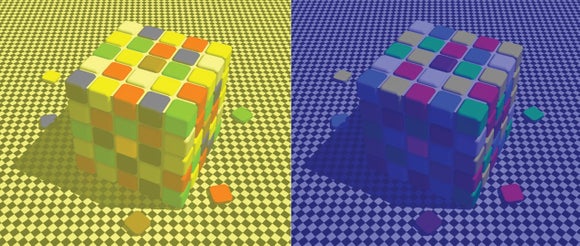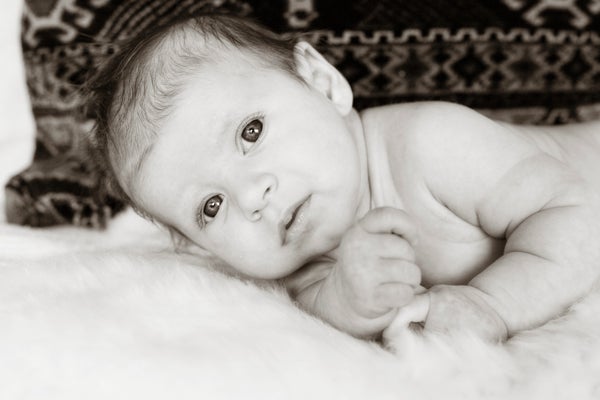This article was published in Scientific American’s former blog network and reflects the views of the author, not necessarily those of Scientific American
Take a look at the red chips on the two Rubik cubes below. They are actually orange on the left and purple on the right, if you look at them in isolation. They only appear more or less equally red across the images because your brain is interpreting them as red chips lit by either yellow or blue light. This kind of misperception is an example of perceptual constancy, the mechanism that allows you to recognize an object as being the same in different environments, and under very diverse lighting conditions.

© Dale Purves, R. Beau Lotto, Surajit Nundy, "Why We See What We Do", American Scientist, vol. 90, no. 3, page 236
Constancy illusions are adaptive: consider what would have happened if your ancestors thought a friend became a foe whenever a cloud hid the sun, or if they lost track of their belongings–and even their own children—every time they stepped out of the cave and into the sunlight. Why, they might have even eaten their own kids! You are here because the perceptual systems of your predecessors were resistant to annoying changes in the physical reality–as is your own (adult) perception.
On supporting science journalism
If you're enjoying this article, consider supporting our award-winning journalism by subscribing. By purchasing a subscription you are helping to ensure the future of impactful stories about the discoveries and ideas shaping our world today.
There are many indications that constancy effects must have helped us survive (and continue to do so). One such clue is that we are not born with perceptual constancy, but develop it many months after birth. So at first we see all differences, and then we learn to ignore certain types of differences so that we can recognize the same object as unchanging in many varied scenarios. When perceptual constancy arises, we lose the ability to detect multiple contradictions that are nevertheless highly noticeable to young babies.
Observe the three snail images below and choose the two that are most similar. The two glossy snails are virtually identical, right? Wrong! If a 4-month old infant could talk, she would tell you that you are crazy (well, she’d probably actually call you “cwazy”, or maybe “dummy poopypants”): clearly, the middle and right images are most alike!

Computer-generated renditions of the same 3D object. A and B were rendered from different light fields but look similar. C looks matte and very different from B, but in reality B and C are closer than A and B. From Yang et al, Current Biology, 2015.
The left and middle snails look nearly identical to you, but in reality are hugely dissimilar in terms of their pixel intensity. For babies it is a piece of cake to tell them apart. We adults instead have no trouble seeing that the middle and right snails are different, even though their physical discrepancy is much smaller than between the middle and left snails. In a study published last December in Current Biology, a team of psychologists led by Jiale Yang, of Chuo University in Japan, found the exact opposite for infants of up to 3-4 months of age.
The scientists studied how 42 babies, aged 3 to 8 months, looked at pairs of images rendered from real 3D objects. Because infants cannot describe what they see, the team measured how long the babies looked at each image. Previous research had shown that babies look for longer times at novel objects than at objects they are familiar with. This meant that the scientists could know, based on how much time a baby spent on an image, if she thought that image was similar to, or different from, the previous picture. If the baby spent less time looking at the second image than the first image, it indicated that she thought she had just seen the same image before (she was bored by it, so she didn’t need to look at it for very long). But if the baby looked at the second image for an equivalent time to what she spent on the first image, it indicated that she found both images equally interesting and surprising.
The data revealed that, before developing perceptual constancy, 3- to 4-month-old babies have a “striking ability” to discriminate image differences due to changes in illumination that are not salient for adults. They lose this superior skill around the age of 5 months. Then, at 7-8 months of age, they develop the ability to discriminate surface properties such as glossy vs matte (which they maintain until adulthood), so they end up perceiving glossy surfaces as very different from matte ones (just as we adults do), even if most of their physical properties remain otherwise unchanged.
The discrimination of surfaces is not the only perceptual domain where we abandon reality for illusion as we grow up. During the first year of life, infants suffer the loss of a myriad discriminatory powers: among them, the ability to recognize differences in monkey faces that are hardly detectable to adult humans, and the ability to distinguish speech sounds in languages other than spoken by their own families. Objective differences become subjective similitudes.
The loss of sensitivity to variant information that we all experienced as babies created an unbreachable gap between us and the physical world. At the same time, it served to tune our perception to our environment, allowing us to navigate it efficiently and successfully... even if it left a large portion of reality forever outside our reach.
